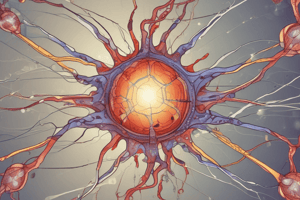Podcast
Questions and Answers
What is the primary function of adrenergic receptors in the body?
What is the primary function of adrenergic receptors in the body?
- To respond to the neurotransmitters norepinephrine and epinephrine (correct)
- To regulate smooth muscle contraction and relaxation
- To regulate parasympathetic nervous system activity
- To stimulate the release of insulin
Which type of adrenergic receptor is responsible for mediating vasoconstriction and smooth muscle contraction?
Which type of adrenergic receptor is responsible for mediating vasoconstriction and smooth muscle contraction?
- Alpha-2 (α2) receptors
- Beta-2 (β2) receptors
- Alpha-1 (α1) receptors (correct)
- Beta-1 (β1) receptors
What is the effect of alpha-2 agonists on blood pressure?
What is the effect of alpha-2 agonists on blood pressure?
- Have no effect on blood pressure
- Increase heart rate
- Increase blood pressure
- Decrease blood pressure (correct)
Which type of adrenergic receptor is responsible for mediating increased heart rate and contractility?
Which type of adrenergic receptor is responsible for mediating increased heart rate and contractility?
What is the primary function of beta-2 agonists?
What is the primary function of beta-2 agonists?
What is the effect of beta blockers on heart rate and contractility?
What is the effect of beta blockers on heart rate and contractility?
Which type of adrenergic receptor is responsible for mediating lipolysis and thermogenesis?
Which type of adrenergic receptor is responsible for mediating lipolysis and thermogenesis?
What is the primary function of alpha-1 agonists?
What is the primary function of alpha-1 agonists?
What is the effect of alpha blockers on blood pressure?
What is the effect of alpha blockers on blood pressure?
What is the primary function of sympathomimetics?
What is the primary function of sympathomimetics?
Flashcards are hidden until you start studying
Study Notes
Adrenergic Receptors
- Also known as adrenoceptors
- A class of G protein-coupled receptors that respond to the neurotransmitters norepinephrine and epinephrine
- Play a crucial role in the sympathetic nervous system, regulating various physiological processes such as:
- Heart rate and blood pressure
- Vasoconstriction and vasodilation
- Smooth muscle contraction and relaxation
- Metabolic rate and energy expenditure
Types of Adrenergic Receptors
- Alpha-1 (α1) receptors:
- Mediate vasoconstriction, smooth muscle contraction, and pupil dilation
- Found in smooth muscle, vascular endothelium, and iris
- Alpha-2 (α2) receptors:
- Mediate negative feedback on norepinephrine release, decreasing sympathetic activity
- Found in presynaptic neurons, pancreatic islets, and adipose tissue
- Beta-1 (β1) receptors:
- Mediate increased heart rate and contractility
- Found in heart, kidney, and adipose tissue
- Beta-2 (β2) receptors:
- Mediate smooth muscle relaxation, bronchodilation, and vasodilation
- Found in smooth muscle, airway epithelium, and vascular endothelium
- Beta-3 (β3) receptors:
- Mediate lipolysis and thermogenesis
- Found in adipose tissue
Adrenergic Drugs
- Sympathomimetics:
- Stimulate adrenergic receptors, mimicking the effects of norepinephrine and epinephrine
- Examples: ephedrine, phenylephrine, pseudoephedrine
- Alpha-1 agonists:
- Increase blood pressure and vasoconstriction
- Examples: midodrine, phenylephrine
- Alpha-2 agonists:
- Decrease blood pressure and sympathetic activity
- Examples: clonidine, guanabenz
- Beta-1 agonists:
- Increase heart rate and contractility
- Examples: dobutamine, isoproterenol
- Beta-2 agonists:
- Relax smooth muscle and dilate airways
- Examples: salbutamol, terbutaline
- Beta-3 agonists:
- Increase lipolysis and thermogenesis
- Examples: mirabegron
- Alpha blockers:
- Block alpha-1 receptors, decreasing vasoconstriction and blood pressure
- Examples: prazosin, terazosin
- Beta blockers:
- Block beta-1 and beta-2 receptors, decreasing heart rate and contractility
- Examples: propranolol, metoprolol
Adrenergic Receptors
- Respond to neurotransmitters norepinephrine and epinephrine
- Crucial in sympathetic nervous system, regulating:
- Heart rate and blood pressure
- Vasoconstriction and vasodilation
- Smooth muscle contraction and relaxation
- Metabolic rate and energy expenditure
Types of Adrenergic Receptors
- Alpha-1 (α1) receptors:
- Mediate vasoconstriction, smooth muscle contraction, and pupil dilation
- Found in smooth muscle, vascular endothelium, and iris
- Alpha-2 (α2) receptors:
- Mediate negative feedback on norepinephrine release, decreasing sympathetic activity
- Found in presynaptic neurons, pancreatic islets, and adipose tissue
- Beta-1 (β1) receptors:
- Mediate increased heart rate and contractility
- Found in heart, kidney, and adipose tissue
- Beta-2 (β2) receptors:
- Mediate smooth muscle relaxation, bronchodilation, and vasodilation
- Found in smooth muscle, airway epithelium, and vascular endothelium
- Beta-3 (β3) receptors:
- Mediate lipolysis and thermogenesis
- Found in adipose tissue
Functions of Adrenergic Receptors
- Alpha-1 receptors:
- Increase blood pressure
- Stimulate smooth muscle contraction
- Dilate pupils
- Alpha-2 receptors:
- Decrease sympathetic activity
- Decrease norepinephrine release
- Beta-1 receptors:
- Increase heart rate
- Increase cardiac contractility
- Beta-2 receptors:
- Relax smooth muscle
- Dilate airways
- Cause vasodilation
- Beta-3 receptors:
- Increase lipolysis
- Increase thermogenesis
Adrenergic Drugs
- Sympathomimetics:
- Stimulate adrenergic receptors
- Examples: ephedrine, phenylephrine, pseudoephedrine
- Alpha-1 agonists:
- Increase blood pressure and vasoconstriction
- Examples: midodrine, phenylephrine
- Alpha-2 agonists:
- Decrease blood pressure and sympathetic activity
- Examples: clonidine, guanabenz
- Beta-1 agonists:
- Increase heart rate and contractility
- Examples: dobutamine, isoproterenol
- Beta-2 agonists:
- Relax smooth muscle and dilate airways
- Examples: salbutamol, terbutaline
- Beta-3 agonists:
- Increase lipolysis and thermogenesis
- Examples: mirabegron
- Alpha blockers:
- Block alpha-1 receptors, decreasing vasoconstriction and blood pressure
- Examples: prazosin, terazosin
- Beta blockers:
- Block beta-1 and beta-2 receptors, decreasing heart rate and contractility
- Examples: propranolol, metoprolol
Studying That Suits You
Use AI to generate personalized quizzes and flashcards to suit your learning preferences.





